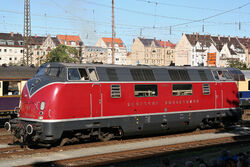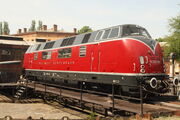
Deutsche Bundesbahn V200 class of 1953, on which the "Warship" was based
Data[]
| Statistic. | Data. |
|---|---|
| Nationality. | West German. |
| Manufacturer. | Krauss-Maffei. |
| Made in. | 1953. |
| Retired in. | 1984. |
| Weight. | weight ca 80.0 t (78.7 long tons; 88.2 short tons). |
| Top speed. | 140 km/h (87 mph). |
| Length. | 18.47 m (60 ft 7 1⁄8 in) (prototype) and 18.53 m (60 ft 9 1⁄2 in) (production). |
| Power source. | Diesel engine. |
| Seats. | The crew only. |
| Railway\tram track gauge. | 1,435 mm (4 ft 8 1⁄2 in) standard gauge and 1,668 mm (5 ft 5 21⁄32 in), Spain. |
| Tractive effort. | N\A, but probably better than average for it's type, era and configureation. |
| Sources. | https://ieonline.microsoft.com/#ieslice, http://trainspo.com/model/746/, http://www.v200-001.de/, http://epoche-3.de/v200.html, http://www.museumseisenbahn-hamm.de/, http://www.db-loks.de/tfz/220.html, http://www.t669.net/, http://www.youtube.com/watch?v=98H_kUUWJTA, http://www.youtube.com/watch?v=6dLx-guKT8A, http://www.youtube.com/watch?v=KqlqFYQTgmg, http://www.youtube.com/watch?v=mewho_VIkOQ, http://v200.richardkrol.nl/ and https://en.wikipedia.org/wiki/DB_Class_V_200 |

A West German DB V 200 in the Technikmuseum, Berlin. Author: Matthew Black.

A V 200 002 in Nürnberg the 14th of September, 1985.
Overview[]
It would become a pan European and W. German icon and W. German railways workhorse. Some were sold to Algeria, Saudi Arabia, Turkey several European states.
History[]
DB Class V 200.0 (from 1968: Class 220) was the first series production diesel-hydraulic express locomotive of the German Deutsche Bundesbahn and - as Am 4/4 - of the SBB-CFF-FFS in Switzerland.
- It was sold on both sides of the Iron Certain.
- Saudi Arabia- Scrapped.
- Italy- In passenger use.
- Spain- Last seen in 2007 for passenger use.
- France- Scrapped.
- Switzerland- Maintenance and non-electric de-energized (power supply turned off for line maintenance) back up service.
- Algeria- Stored after the maintenance crew abandoned after work was done.
- Albania- Stored and in disrepair due to lack of staff and appropriate skills.
- E. Germany (now Germany) All on freight and maintenance service.
- W. Germany (now Germany) A few are preserved or in freight and charter services.
Export versions[]
Many export version types were made and sold over the years:
British Rail Warship Class[]

D829 'Magpie' waits at Paddington Railway Station in 1961. Author: Ben Brooksbank.
Also see- British Rail Class 42, British Rail Class 43 and Warship Class.
The British Railways "Warship" class locomotives built in Britain between 1958 and 1962 were based on Krauss-Maffei's V 200.0 design, including the distinctive shape. British Railways licensed the design from Krauss Maffei and various British engineering firms built the different component parts, also under license.
ML2200 (JŽ D66/761)[]
Krauss-Maffei ML 2200 C'C' Based on V 200 series, in 1956 Krauss Maffei built three ML2200 (designated JŽ D66, later 761) series locomotives for Yugoslav Railways. The number of axles was increased from 4 to 6 to cope with the low maximum axle load on Yugoslavian tracks. The locomotives remained in working order until 1991 and are now stored at a railway museum in a suburb of Belgrade.
ML2200/ML3000 - V 300 001/230 001-0[]
DB Class V300 A fourth example of the ML 2200 C'C' was built at Krauss-Maffei's own expense, awaiting a buyer, but the Yugoslavian state railways made no further purchases. In November 1957 Krauss-Maffei commenced a rebuild of the locomotive with more powerful engines and bigger transmissions, in the hope that it would be suitable for the Deutsche Bundesbahn. The designation given to the locomotive by the builder was ML3000 C'C'. Krauss-Maffei had hoped that DB would order more of the ML3000 design to replace steam locomotives in freight service, but instead DB opted for a modest uprating of the original V 200.0 in the form of the V 200.1. Eventually DB bought the locomotive and it worked until being retired in 1975.
ML2700CC (TCDD DH27)[]
TCDD DH27000 In response to the 1955 visit to Yugoslavia, Greece and Turkey by one of the V200 prototypes, Turkish Railways (TCDD) ordered three Krauss Maffei ML2700 locomotives in 1960. As with the Yugoslavian ML2200 locomotives the Turkish locomotives had six axles, however the external design was completely different from the V200 carbody style with the final product looking more like contemporary US road switcher locomotives with a European twist. The locomotives worked freight and passenger trains radiating from Ankara until TCDD retired them in 1982.
RENFE Class 340[]
RENFE Class 340 Thirty Two locomotives of this type were built, ten by Krauss Maffei and exported to Spain, and twenty-two built in Spain by Babcock & Wilcox. Being Iberian gauge vehicles the overall dimensions are larger, and the engines are 16 cylinder versions, giving a total engine power of 4000 hp.
Technology[]
It was a milestone in West German and European rail engineering. The V 200 had two fast-running (1500 RPM) V12 diesel engines. The transmission was hydraulic, each engine drove one bogie set via a hydraulic torque converter. The maximum speed was 140 km/h. The prototypes had a maximum power of 1,471 kW, the V 200.0 had a power of 1,618 kW. Unlike some other diesel-hydraulic locomotives the V 200 was renowned for its high reliability. Maybach (type MD650), Mercedes-Benz (type MB820Bb) and MAN (type L 12 V 18/21) engines were used. The hydraulic transmissions fitted to the locomotives were supplied by Maybach (type Mekydro K104U) and Voith (type LT306r/rb).
Although differing in several ways - for example the Mekydro K104 transmission had a single torque converter and four mechanicanical gear stages while the Voith L306 had three different-sized torque converters - the engines and transmissions were designed so that the various types were completely interchangeable, not just amongst V 200.0 but with other locomotive types (V80/V100) and diesel multiple units (VT11, VT08 & VT12) that DB ordered around the same time as the V 200.0. It was not uncommon to find a single locomotive with one Mercedes engine and one Maybach unit running together. The MAN engines were only fitted to five locomotives in 1959 as an experiment and these locomotives eventually had their engines replaced with the more common Maybach or Mercedes engines.
To reduce weight, the locomotives had unusual inside framed bogies. Combined with the high driving position and rounded body, this gave the V 200 a very distinctive appearance.
DR Class V 200[]
The Deutsche Reichsbahn of the GDR had its own class with the designation V 200, later renamed DR Class 120. This were Russian made diesel-electric locomotives, nicknamed Taigatrommel (Taiga tundra and trommel as drums in English i.e. Tundra Drums), referring to their typical noise and a cynical reference to the Siberian landscape of their Russian homeland.
After the reunification of Germany these engines were classified by the new Deutsche Bahn as Class 220 as well, since all Western German V 200 units were out of service by that time.
Also see[]
- GDR
- FRG
- British Rail Class 42
- British Rail Class 43
- BR Warship Class